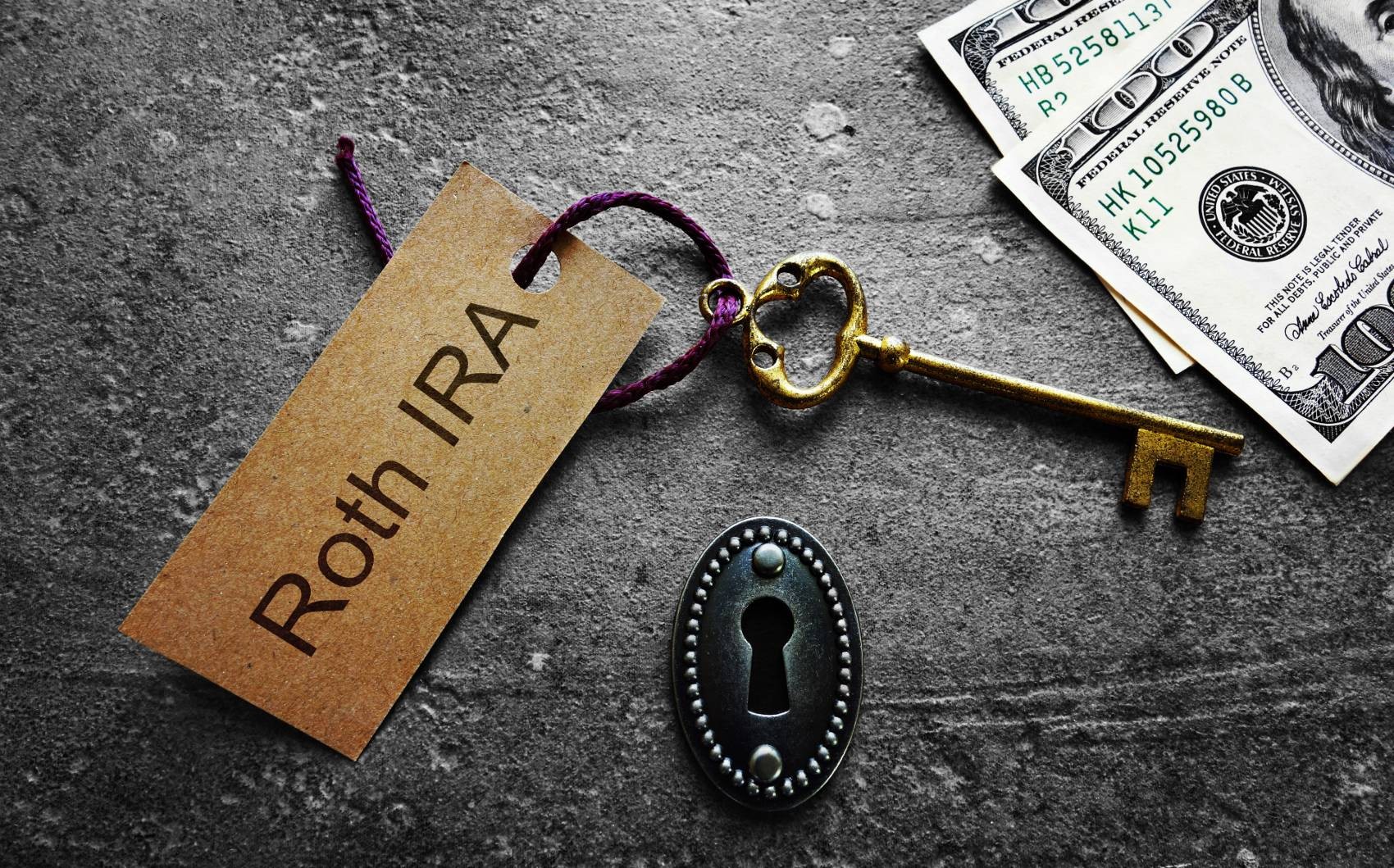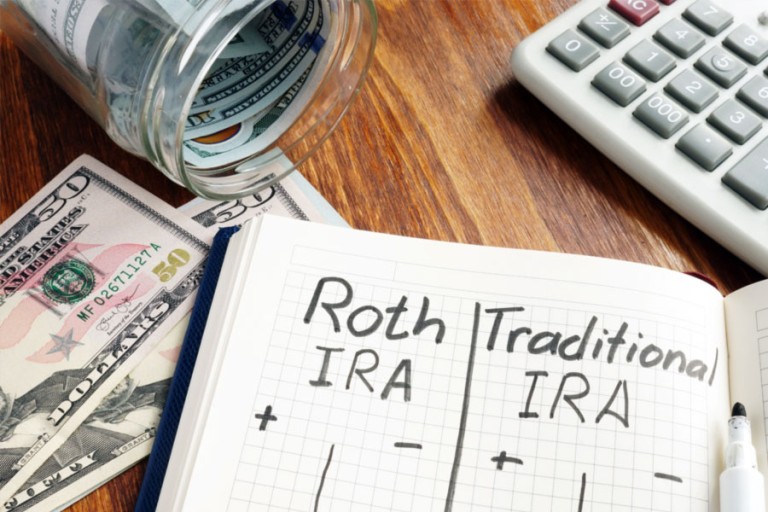Roth IRAs are a great tool to help fund your retirement plan. Like many other tools, a ROTH IRA has attractive features and limitations. How to use these features to one's advantage requires financial planning and some helpful advice from William Bevins CFP®, an experienced fiduciary advisor.
What is a Roth-IRA
The primary difference between Roth IRAs and traditional IRAs is their respective tax treatment. A Roth IRA is an individual retirement account that provides tax benefits after you contribute your post-tax income. With a Roth IRA, you can enjoy the potential of consistent tax-free growth and withdrawals after age 59½ if your account has been open for at least five years. This is one of the most attractive advantages that come with using this type of retirement plan. Put simply, you pay taxes on the money entering your Roth IRA up front, and then all future withdrawals are free of any taxation.
How does a Roth IRA work?
Invest the funds you have already paid taxes on in a Roth IRA and watch your money grow. As your savings accrue with time, upon retirement, you can withdraw the funds without subjecting yourself to any additional taxes. You can contribute to a Roth IRA in multiple ways, such as annual contributions, transfers of funds from other accounts (like traditional IRAs), and rollovers from qualified retirement plans.
The Internal Revenue Service (IRS) regularly updates the amount that can be deposited each year in all IRA varieties. Both Traditional and Roth IRAs have the same contribution limits. If you manage more than one IRA, it's important to keep in mind that the total amount contributed must not exceed the yearly limit. Make sure your contributions stay within these restrictions and take full advantage of all available tax benefits. This is a key element of retirement planning.
Just like other qualified retirement plan accounts, the money invested in a Roth IRA can grow without any taxes. By comparison, a Roth IRA is less restrictive than other types of accounts. With a Roth IRA, the account holder can keep it active for as long as they'd like; there is no requirement to withdraw funds during their lifetime- unlike with 401(k)s and traditional IRAs.
When should I open a Roth IRA?
In general, if you are eligible to open a Roth IRA - based on your income and filing status - and have extra money available for saving, then the best time is now. When your income is in a lower-than-normal cycle, it's the perfect time to make an investment or transition from one type of IRA account to another. Specifically, converting your traditional IRA into a Roth IRA can be very advantageous. Paying taxes right away rather than later usually indicates that it would be advantageous to make the switch to a Roth IRA when we have lower incomes or during times of reduced federal income tax rates.
Can I have a Roth IRA and a 401k?
You are eligible to both contribute to a Roth IRA and 401(k), Simplified Employee Pension (SEP), or Savings Incentive Match Plan for Employees (SIMPLE) IRA, depending on your income level. Nonetheless, every type of retirement account has its annual contribution limits.
Are you age 50 or older? If so, maximize your retirement savings for 2023 by contributing up to $6,500 annually into either a Traditional IRA or Roth IRA. Investing in a retirement plan not only brings you financial stability and assurance now but acts as an incentive to ensure that your future is prosperous. As of 2024, the IRA annual contribution limit is set at $7,000 plus an extra $1,000 for eligible individuals. Should your annual taxable compensation be lower than the specified amount, then that sum will act as a limit for you.
Regardless of age, you can make contributions to a Roth account if you earn taxable income. This includes those past full retirement age. A husband or wife who is an active income earner can make a Roth IRA replacement for their spouse that does not receive any form of payment.
For your retirement planning, the maximum contribution amount you can put towards your 401(k) for 2023 is $22,500 and in 2024 it will be increased to $23,000. If you are age 50 or older during this time period, then you may also take advantage of a bonus catch-up limit of an additional $7,500. In 2024, the catch-up amount for savings increases to an impressive $8,000.
Take advantage of a Roth IRA and contribute after-tax dollars to an employer-sponsored retirement plan. This strategy allows you to maximize your retirement savings, so don't miss out on this excellent opportunity.
Utilizing these tax-advantaged accounts, you can rapidly grow your nest egg more quickly when compared to non-tax-advantaged investments. With this approach, your balances grow tax-free and can accumulate wealth with ease and peace of mind utilizing the tax deferral. Optimizing your contributions to retirement investments each year can grant you a more expeditious opportunity at retiring, assuming that all investment decisions are well conceived.
It is difficult to anticipate which tax bracket you will fall into in your retirement, and even more challenging to predict the exact rates of taxation when that time comes. Thus, it’s highly beneficial to have some retirement funds that you have already paid taxes on (e.g., a Roth IRA)—as well as some that you haven't yet, such as a traditional 401(k). This will help ensure maximum financial security for your future. Subsequently, you can arrange your distributions to reduce your tax responsibility as much as possible.
Do I qualify for a Roth IRA?
No matter your age, you're eligible to open a Roth IRA. The sole requirement is that the money must be from earned income. Teenagers can quickly accumulate funds for their future by taking on a part-time job such as babysitting and investing their earnings into an IRA. The amount they can invest is either the money earned or up to the contribution limit - whichever comes first.
Before investing in your Roth, consider contributing the maximum amount you can into your workplace retirement plan so that you can leverage any employer-matching contributions on offer. Investing in employer-sponsored retirement plans is like acquiring free money; it's the perfect way to boost your nest egg quickly.
Remember, once your Modified Adjusted Gross Income exceeds a certain limit, the amount you are allowed to contribute to a Roth IRA may be reduced or eliminated.
What are the 5 benefits of investing in a Roth-IRA?
- If you've been contributing to a Roth IRA for at least 5 years and are over 59 ½, you will be able to withdraw your investment earnings without being taxed when retirement rolls around!
Tax-Deferred Growth: When contributing to a Roth IRA, your contributions will not be subject to taxation in the year of contribution or in any subsequent years (provided that your Modified Adjusted Gross Income is within the allowable limits). This allows your returns to build on themselves without being diminished by taxes annually, therefore maximizing their potential.
Flexible Withdrawal Rules: Withdrawing from your Roth IRA without incurring a penalty is allowed beginning at age 59½ provided that the account has been open for five consecutive years or more. Starting at age 59 ½, you have the option to draw out emergency funds comprised of contributions and any associated earnings.
No Required Minimum Distributions: For customary IRAs, individuals must commence withdrawing funds at the age of 72. With a Roth IRA, you don't have to worry about mandatory withdrawals - your money can stay in the account and grow or be withdrawn tax-free, it's your choice.No Required Minimum Distributions: For customary IRAs, individuals must commence withdrawing funds at the age of 72. With a Roth IRA, you don't have to worry about mandatory withdrawals - your money can stay in the account and grow or be withdrawn tax-free, it's your choice.
Attractive Contribution Limits: Those who are eligible to contribute can take advantage of the generous $6,500 annual contribution limit for 2023 ($7,500 for those aged 50 or older) when investing in a Roth IRA. Don't miss this opportunity to secure your financial future! For 2024, the maximum total annual contribution across all IRAs (including Traditional IRAs) is a generous $7,000 ($8,000 for those 50 years of age or above). If your Modified Adjusted Gross Income (MAGI) is above a certain threshold, the contribution limit may be reduced or eliminated. To ensure that you are making optimal financial decisions regarding your contributions, it is highly recommended that you consult William Bevins CFP® for assistance and guidance.
Conclusion
By investing in a Roth IRA, you can capitalize on its tax advantages while also building wealth for your golden years. Invest a bit of time researching the various investment options available within the account to guarantee that you are making intelligent decisions. To get the most out of your investments, make sure to review the contribution limits and eligibility requirements. Investing in a Roth IRA right now could be a life-altering decision when it comes time for you to retire - don't miss out on this valuable opportunity!
A Roth IRA is an excellent way to secure your retirement and maximize your savings due to its tax-free earnings, offering you a greater degree of flexibility than other investments. If you're serious about pursuing your retirement goals, it is a good idea to reach out to a fiduciary financial advisor who can help guide you in selecting the right account and strategy.
Related Topics
Which is better a 401k or a Roth IRA?
Ever wondered what the difference is between a traditional and Roth 401(k)? Put simply, it comes down to when you pay your taxes. A traditional 401(k) allows for contributions with pre-tax money, which means that you receive an immediate tax benefit as part of lowering your income taxes in the current year. Your contributions and financial gains can increase without incurring taxable income until it's time to withdraw your funds. If you withdraw funds at that point, it will be treated as ordinary income and taxed accordingly according to your current tax rate. You may also have additional state taxes due on the transaction. Unless you meet one of the few exceptions, you will pay an additional 10 percent penalty if your age is under 59½.
With a Roth 401(k), the order of operations are reversed. You can contribute to your retirement account with post-tax dollars, which means you won't be able to enjoy any upfront tax advantages. Once the account achieves the five-year rule, distributions from retirement savings and profits from a Roth IRA are tax-free when an individual reaches 59 ½.
Ultimately, choosing when to pay taxes is a personal decision that will be based on your timeline and what the future holds. You must consider whether it's more beneficial for you to make payments now or in the foreseeable future.
Although a tax deduction looks attractive at first, it is vital to consider the long-term ramifications. With the current taxation system, every dollar you withdraw from a traditional 401(k) account can be reduced by up to 30%, or even more when you reach retirement age – all depending on your tax bracket. Therefore, you must diligently save more money to ensure your retirement income is adequately funded.
If you're young and believe that your future earnings will be greater, thus leading to a higher tax bracket, the Roth 401(k) could be an ideal choice for you. Regardless of your age, you should still consider the possibility of investing in a Roth. Whether you're in your 40s, 50s, or 60s - it's worth examining if this option is right for you.
Retirees should be wary of the possibility that their withdrawals from traditional retirement accounts could thrust them into a higher tax bracket, even if they're currently in a lower-income tax group. This could result in a bigger tax bill, possibly including taxes on your Social Security benefits. Additionally, it will reduce the amount of disposable income you have to use. Furthermore, higher taxable income may mean that your Medicare B premiums when you retire cost more than they otherwise might have done.
What is the downside of a Roth IRA?
Apart from not being immediately deductible and having income caps, Roth IRAs have several other drawbacks to consider.
While employers can provide and administer retirement savings plans for their staff, Roth IRAs are not included in the list of options. While employers cannot set up Roth IRAs and contribute to them on behalf of their employees, any employee can leverage their income from work to make personal contributions into a Roth IRA account.
Employers can conveniently set up a Payroll Deduction IRA with their preferred financial institution to help employees easily contribute to their own Roth IRAs. These contributions are made directly from employee paychecks after taxes have been taken out. Unfortunately, this plan does not permit the employer to contribute to individual employee Roth IRAs.
Furthermore, should you not follow the IRS regulations when taking money from a Roth IRA, you may incur a penalty. A 10% tax may be imposed on the amount of your distribution, so it's best to proceed with caution. Substantial fines may be imposed if you withdraw money from the account within five years of its inception, or before turning 59 1/2. You and your beneficiaries won't be penalized if the distribution was held for the minimum five-year holding period plus the following conditions:
- Due to Disability
- Upon or after death
- Use for higher-education expenses
Take advantage of a one-time distribution to assist you in purchasing your first home. The exception allows an individual to make tax-free withdrawals of up to $10,000 from their Roth IRA without facing any penalty. This is the perfect way for anyone looking into buying a property soon to save money and still make progress on their financial goals.
Can I borrow money from a Roth IRA?
It is impossible to borrow money or obtain a loan from an IRA. When the need arises, there are a few ways to access funds from your traditional IRA or Roth IRA. Regardless of your age, whether you qualify for an exception or own a Roth IRA—or can replace the funds within 60 days—there is always the potential to take money from your traditional IRA. Knowing how to withdraw money from an IRA without facing a penalty is important and here are the steps you need to take:
If you’re 59½ or older, withdrawing funds from your traditional IRA is possible with no penalties, though you may be responsible for income taxes if the original contributions were deducted. If you are 59½ years or older and have had your Roth IRA for five consecutive years, then you can withdraw both contributions and earnings without paying any taxes or penalties.
If you qualify for an exception, even under 59½, you can still withdraw money from your IRA penalty-free, such as purchasing a first home. Before you withdraw money from either a traditional or Roth IRA, take some time to review the withdrawal rules and see if your purpose for taking out funds meets the criteria.
If you have a Roth IRA, you can withdraw the funds you've deposited into your account anytime, free from any penalty or tax implications. When withdrawing money from your plan, you must be mindful to withdraw the original contributions and not any of the investment profits (such as dividends or interest earned on those contributions). Withdrawing your earnings before the designated time can result in a 10% penalty fee and an income tax on that portion of your withdrawal.
If the money can be retuned in 60 days or less, then a 60-day rollover might be the answer. According to IRS regulations, you have a 60-day grace period in which you are allowed to move funds from one IRA account into another or back into the same account. During that period, you can choose to do whatever you deem fit with the payment. It's a complex and potentially hazardous move; however, if all of the conditions are fulfilled, it is possible to access funds from your IRA without facing any taxes or fines.
About William Bevins, CFP®
William Bevins is a CERTIFIED FINANCIAL PLANNER™ and wealth advisor serving Middle Tennessee. His practice focuses on writing financial plans, wealth management, offering advice, and building suitable investment portfolios for individuals, small to medium-sized businesses, and family offices. He may be contacted by email at [email protected].




